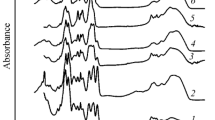Summary
Introduction of simple alkyl groups at the C-2 nitrogen of chitin and some properties of the resulting N-alkyl-chitins have been examined. Chitosan was fully deacetylated and treated with three kinds of aldehydes, formaldehyde, acetaldehyde, and pentanal. The Schiff bases of chitosan, whose extents of substitution were dependent on the amount of aldehydes, were reduced with sodium cyanoborohydride to N-alkylated chitosans. The N-alkyl-chitosans were then transformed into the corresponding N-alkyl-chitins by acetylation with acetic anhydride followed by transesterification to remove partly formed O-acetyl groups. The resulting N-methyl-, ethyl-, and pentyl-chitins were amorphous and showed improved affinity for organic solvents.
Similar content being viewed by others
Author information
Authors and Affiliations
Additional information
Received: 13 December 2001/Revised version: 11 January 2002/Accepted: 17 January 2002
Rights and permissions
About this article
Cite this article
Kurita, K., Mori, S., Nishiyama, Y. et al. N-Alkylation of chitin and some characteristics of the novel derivatives. Polymer Bulletin 48, 159–166 (2002). https://doi.org/10.1007/s00289-002-0015-1
Issue Date:
DOI: https://doi.org/10.1007/s00289-002-0015-1



